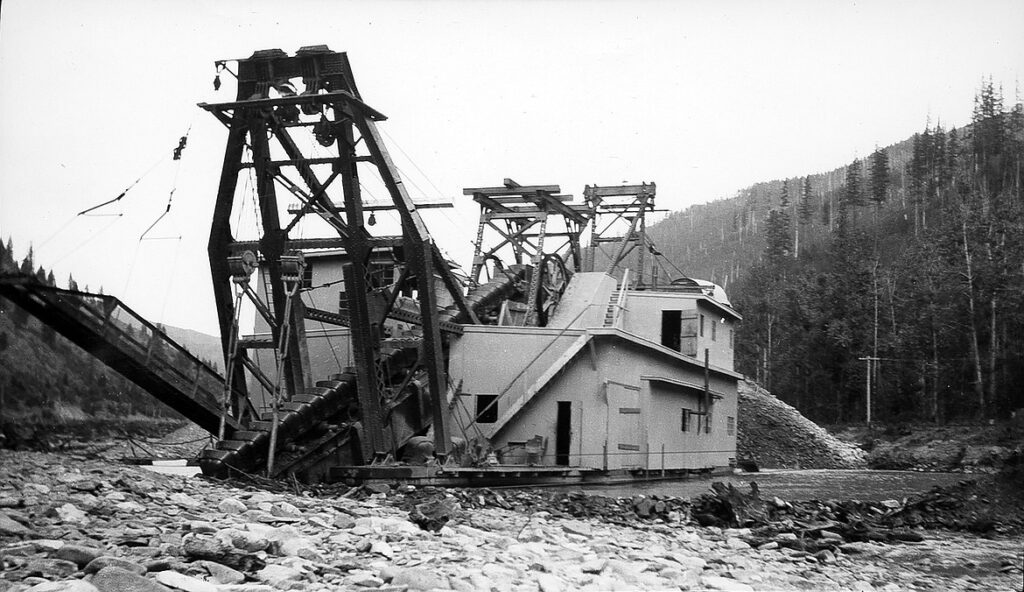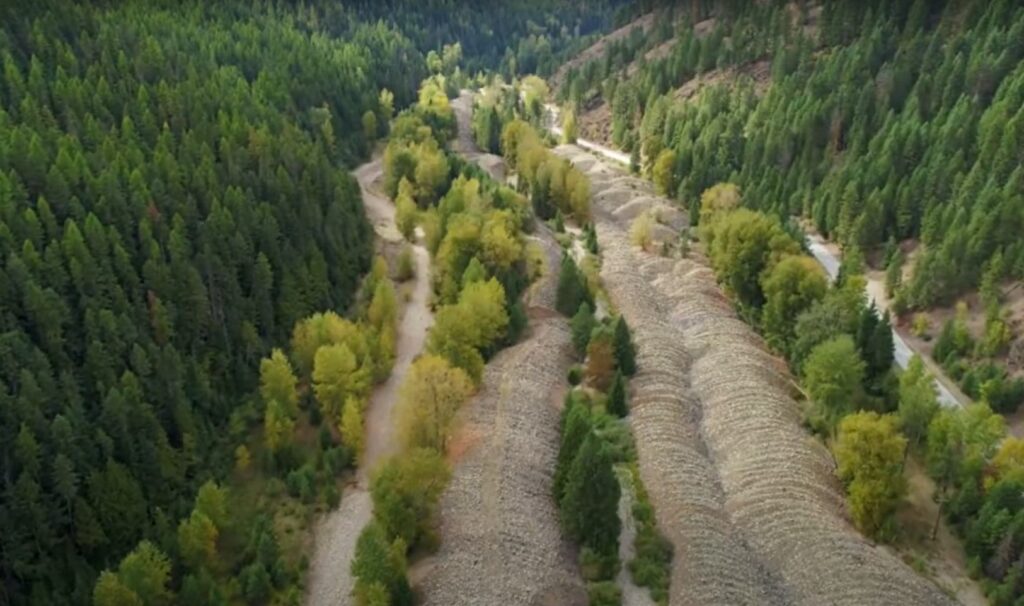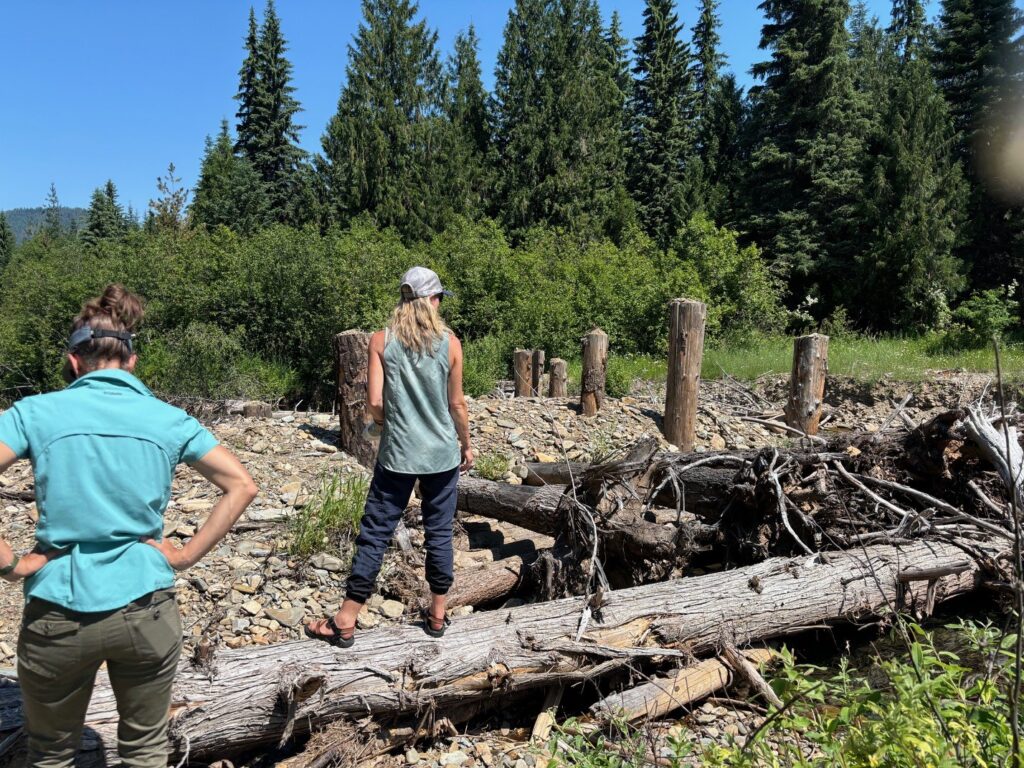Photos courtesy of Idaho Forest Group
This past September, nearly 2,000 acres of North Idaho forest along Prichard Creek, a tributary of the Coeur d’Alene River between the town of Prichard and Thompson Pass, was protected from future development thanks to an Idaho Forest Group (IFG) donation of a conservation agreement to Kaniksu Land Trust. Portions of this section of Prichard Creek stand out to many who pass by due to the large piles of rock surrounding the waterway. These rock pile features were left behind from mining by the Yukon Gold Company that involved a frenzy of nearly non-stop, 24-hours-a-day dredging with a massive six-stories-high machine and crew of 12 men between 1917 and 1926.

The conservation agreement encompasses 1,023 acres of riparian habitat (10.5 miles of the 14-mile stream), 921 acres of forested uplands, and equates to an over three-million-dollar donation by Idaho Forest Group (IFG), one of the largest lumber producers in North America that owns and manages nearly 70,000 acres of land in Idaho and Washington, operates six sawmills, and employs nearly 1,300 workers. The Prichard Creek conservation agreement, a conservation easement between IFG and Kaniksu Land Trust where IFG donated the value of future development potential, permanently protects the area. The agreement also outlines continued restoration of the tributary and adjacent national forest public lands, in partnership with several non-profit conservation organizations and natural resource managers, including Trout Unlimited and Restoration Partnership.
“IFG’s commitment to forest stewardship and sustainability is at the heart of this work,” says IFG Owner, Marc Brinkmeyer. “We are proud to have partnered with many local, state, federal and conservation agencies to develop a multi-phase restoration plan to ensure the protection of this important area that offers a key habitat and holds such rich history.”

Years of hard-rock and placer mining have greatly impacted Prichard Creek, its floodplain and fish habitat. The creek had been severely degraded by the past mining that removed thousands of tons of sediment, created five-mile-long rock piles, altered the creek’s shape, reduced vegetation, eroded banks, increased sediment in the water, and caused a three-mile stretch to flow subsurface during summer months.

The first phase of the restoration project began in the summer of 2023 and included the strategic installation of natural wooden structures along a four-mile stretch of Prichard Creek (to restore water flow) and planting vegetation (to enhance ecosystems and naturally support the wooden structures). This phase was funded by the Restoration Partnership—a group of federal, state, and tribal trustees—who aim to mitigate environmental damage from historical mining practices. The Idaho Department of Environmental Quality served as the fiscal sponsor for the project and Trout Unlimited managed the project with significant involvement from IFG.
“We’ve seen a lot of positive outcomes a year later, including beaver activity, vegetation establishment, improved in-stream habitat diversity and increased use of the channel by cutthroat trout,” says North Idaho program manager for Trout Unlimited, Erin Plue. “We are very proud of the work this collaboration has done to date and look forward to continued restoration and protection.”
Despite the legacy of mining in and around the creek, long-term heavy metal contamination in the watershed is minimal compared to sections of the Coeur d’Alene River within the designated Superfund Site area of the Silver Valley and farther downstream, says Plue. “There don’t seem to be any lingering contamination hot spots, as most of the mill sites were cleaned up back in the early 2000s.” This is good news for fish, other wildlife, and anglers and means that despite the piles of mining debris that remain along much of this section of the creek, restoration efforts already underway can more quickly turn things around.
Ideally, the next phase of restoration will be in that central part of the Prichard Creek conservation parcel with the rock piles, says Plue. “It’s still in the planning phase,” she says, “but it’s looking like a significant portion of the piles would be removed to restore the flood plain over time as funding becomes available.”

Creek and fishery restoration efforts involve restoring meanders to the stream, but previously dredged sections of the creek bed that were excavated as deep as 25 feet in some places now allow sections of Prichard Creek to flow underground during low-flow summer months, making future restoration efforts to restore above-ground flow more complex and expensive, explains Plue. “A lot of this project is built around trapping sediment in some areas and moving it to others to create pools and stability.” In places where past dredging disturbed millions of years of fine sediment pockets that previously allowed the water to flow over, new underground dams of rock, logs, and fine sediments will need to be re-constructed to bring the above-ground stream flow back, she says.
Future phases will focus on improving access to fish habitats, securing water resources, providing public recreational access, ensuring forest health, preventing land conversion, halting further mining, and creating educational venues. The long-term project will involve securing grants for continued restoration efforts over many years. Plue emphasized that ongoing collaboration with Restoration Partnership has been and will continue to be crucial to the full restoration of Prichard Creek. The finalization of the conservation agreement is a testament to the dedication and collaborative efforts of IFG and its many partners that include Idaho Department of Environmental Quality, Idaho Fish & Game, Idaho Bureau of Land Management, Idaho Department of Lands, Idaho Fish & Wildlife Foundation, U.S. Fish & Wildlife Services, Coeur d’Alene Tribe, Trout Unlimited, the Restoration Partnership, and Kaniksu Land Trust.













